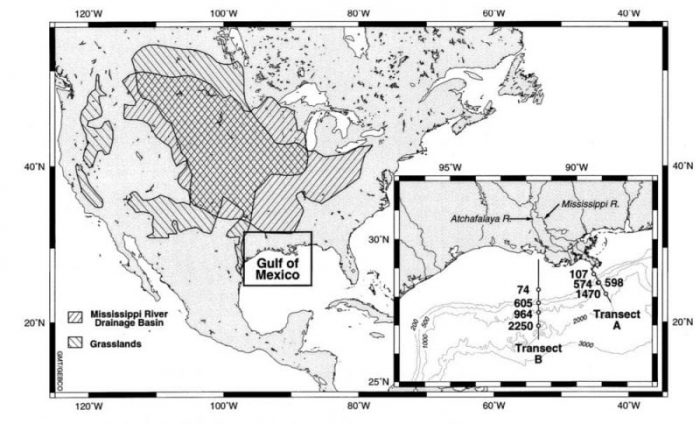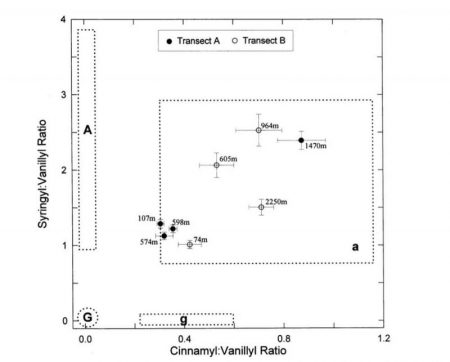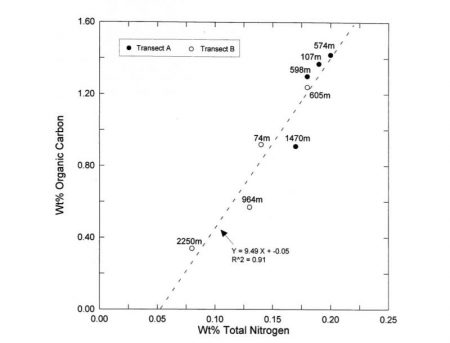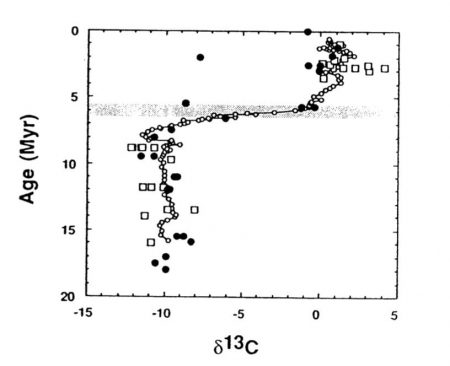
Organic matter (OM) is known to be one of the primary factors involved in the global carbon cycle as well as a mechanism for carbon sequestration. Despite its significance, little is known about the sources, role, and importance of OM in coastal environments. Several studies suggest that terrestrial OM is deposited primarily on the coastal shelves of the Gulf of Mexico, and that little is deposited out on the continental shelf. Several other studies that markedly contrast to these studies, however, indicate that significant amounts of the OM deposited in offshore sediments is of terrestrial origin.
This paper focuses primarily on a study published by professor Miguel Goni in the northwestern Gulf of Mexico. This study sides with the latter of the two arguments, suggesting that the parameters in which the foremost stated group used were insufficient in estimating the sources of the OM. They implemented several techniques including d13C ratios, radiocarbon analyses, and the abundance of lignin phenol in order to determine the sources of OM in the shelf and slope sediments.
The need to sort out the debate over the contribution of terrestrial OM in coastal waters is vital. Previous estimates of OM in coastal sediments primarily attribute OM to marine sources (Chikaraishi et al., 2005), not factoring in the attribution of C4 OM to the Gulf. This deduction would skew the estimates of past primary productivity as well as call for a reassessment of the autochthonous and allochthonous contributions to OM in coastal sediments. Due to the importance of coastal organic carbon in the global carbon cycle, this is a vital parameter that must be delineated.
Description of Regional Characteristics
The northwestern Gulf of Mexico is the primary study site that will be focused upon.

A map comprising the North American grasslands, the Mississippi River drainage basin, as well as the transects sampled by Goni’s team.
The primary source of fresh water to this region is the Mississippi River, comprising 70-90% of the total fresh water input into the Gulf of Mexico. The Mississippi river drains an area of 3.3×106 Km2, which equates to approximately 40% of the continental US, and delivers roughly 210 x 106 tones of sediment per year to the Gulf of Mexico, the largest source of sediment to the region. The sediments deposited in the Gulf form well-developed deltas nearshore and are carried offshore due to resuspension and turbidity currents. Marine primary productivity in the continental shelf of the Gulf of Mexico exceeds 100 g C/m2/yr, although somewhat limited in near shore waters due to turbidity and entrainment of sediments in the water.
The Mississippi River drains the majority of North America’s grasslands. These grasslands are primarily composed of C4 grasses and C3 woody plants; the C3 woody plants are predominant in more northern regions while the C4 grasses are mostly located further south. This predominance of C3 plants in the northern latitudes and C4 grasses in the southern latitudes is due to the chemical processes that take place in each photosynthetic pathway. C4 plants dominate when temperatures are above 10°C, while C3 plants are hardier and can withstand temperatures well below 10°C. The majority of trees, most shrubs, herbs, sedges, and cold weather grasses utilize the C3 pathway, comprising the large majority of photosynthesizing terrestrial plants.

The distribution of C3 plants with respect to latitude.
Although the C4 pathway is not as widespread as the C3 pathway, some of the major types of plants that are abundant in North America’s grasslands such as warm weather grasses as well as crops such as sugar cane and corn utilize this pathway.
Location
Goni et al., (1998) collected sediments linearly along two transects perpendicular to the shore of the Gulf of Mexico. These transects cut across the continental shelf and into to the abyssal plain, transect A running NW-SE along the Southwest Pass, a main distributary of the Mississippi River, while transect B running N-S parallel to the Atchafalaya River outflow. Sedimentation rates were found using 210Pb inventories, and it was determined that the rates were inversely correlated with water depth. Sedimentation rates varied from 0.8 cm/yr at the 107m station (the closest on shore sample collected for transect A) to 0.005 cm/yr at the 1470m station (the farthest off shore sample collected for transect A). Lin, (1990) found that the sediments located in this area were primarily clay (50-75%), with silt comprising 25-45%, and fine sand contributing 1-10%.
Description of C3 and C4 Photosynthesis Pathways
The most common photosynthetic pathway is the C3 pathway, characteristic of the majority of trees, most shrubs, herbs, cold weather grasses and sedges on earth. The C3 pathway, or Calvin cycle, involves photosynthesis with an initial CO2 forming phosphoglyceric acid, a 3-carbon acid. In comparison, the C4 path, also known as the Hatch-Slack cycle, combines CO2 in photosynthesis with phosphoenol pyruvate and produces a 4-carbon acid. The majority of C4 plants comprise warm weather grasses. These two different pathways have very distinct d13C signatures; C3 plants tend to have d13C signatures ranging from -23 to -35‰ and averaging approximately -26‰, while C4 plants are more enriched in 13C and thus have d13C signatures from about -10 to -14‰, with an average at approximately -13‰.
The Mississippi River basin comprises both C4 and C3 plants, each representing a large portion of the total OM that is entrained in the river. A combination of these woody plants and grasses gives bulk d13C signatures that range from -17 to -23‰, furthermore marine derived OM gives d13C signatures of -18 to -22‰. Herein lies the dilemma of trying to quantify the contribution of terrestrial OM to coastal surface sediments. Due to the mixture of C4 and C3 plants that comprise the Mississippi Delta, the terrestrial sediments that the Mississippi deposits into the Gulf of Mexico have d13C values similar to that of marine OM.
The Use of d13C to Denote C4 and C3 Plants
In the atmosphere, carbon naturally occurs as 13C and 12C, and although 12C makes up the vast majority of carbon in the atmosphere, 13C is present in small proportions. Even though 13C is discriminated against when plants photosynthesize, thus making the proportion of 12C used much more than 13C, C3 and C4 plants discriminate against this 13C atom in different magnitudes. Thus the measuring technique d13C measures the ratio of 13C to 12C against a standard, and depending on the value obtained, one can determine whether the OM came from a C3 or C4 plant.
Previous studies, such as Gearing et al., (1977) determined that land derived OM did not contribute substantially to the bulk OM in the surface sediments off the shore of the Gulf of Mexico. In this study Gearing et al., (1977) was shortsighted by only comparing two end members to the d13C value. They presumed that the terrestrial OM coming from the Mississippi Delta was of C3 origin and thus compared d13C values for C3 plants with the d13C values of typical marine sources. Given the large fraction of C4 grasslands that the Mississippi River delta is comprised of, this simplification could have caused a significant oversight of the terrestrial OM contribution to the Gulf.
Goni et al., (1998) found that the d13C values for all the sediments analyzed fell into a narrow range of -21.7 to -19.7‰. Although there was a minimal trend toward more enriched d13C values with increasing water depth in transect A, there appeared to be no trend in the d13C values for transect B.

Bulk compositions of each sample along transects A and B in the Gulf of Mexico.
The narrow range in d13C values that Goni et al (1998) found are consistent with both the d13C value of marine OM as well as the d13C value of OM that is composed of C3 and C4 plants. Therefore the d13C alone is not enough to characterize the OM as terrestrial (C3 or C4) or marine derived.
Lignin as a Biomarker in Terrigenous OM
Complicating this dilemma of overlapping d13C values, a significant amount of terrestrial as well as marine derived OM can be subjected to microbial degradation. Microbial degradation distorts the results for several analytical techniques, therefore making it necessary to identify the degradation and take it into account. To delineate this Goni et al., (1998) analyzed the sediments using Isotope ratio monitoring- Gas Chromatography – Mass Spectrometry (irm-GC-MS). Using this method they were able to analyze terrestrial biomarkers, specifically, lignin-derived CuO oxidation products. Lignin, a molecule that is unique to vascular plants, can be used to trace terrigenous OM in sediments. By means of this method, one can determine the origin of OM as C3 or C4.
Goni et al., (1998) implemented several parameters to characterize the sources of lignin phenols and terrestrial OM in coastal sediment samples. Lignin phenols are categorized into families of compounds (vanillyl, syringyl, p-hydroxy, and cinnamyl) and thus certain types of plants have lignin phenols that are unique to themselves. While all vascular plants have vanillyl phenols, angiosperms have syringyl phenols and gymnosperms lack syringyl phenols. Employing this constraint, Goni et al., (1998) measured the ratio of syringyl to vanillyl phenols (S/V), which was then used to determine whether the lignin in the OM was of angiosperm or gymnosperm origin. Angiosperm, a C3 plant, refers to hardwood plants such as oaks and maples; while gymnosperm, also a C3 plant, refers to softwood plants such as conifers. In addition to the S/V ratio, Goni et al., (1998) measured the ratio of cinnamyl to vanillyl phenols (C/V) in the coastal sediments. Given that cinnamyl is a type of lignin found mainly in nonwoody tissues such as grasses and tree leaves, this ratio aids in determining the proportion of woody versus nonwoody plants.
Goni et al., (1998) found that all of the samples taken in the Gulf of Mexico had S/V ratios ≥1 and C/V ratios ≥0.3. In transect A, the S/V ratios tend to increase from 1.3 at the shallower stations to 2.4 at the 1470m station; S/V ratios for transect B follow the same general trend, despite a slight decrease at the last 2250m station. This positive trend of S/V indicates that the relative proportions of angiosperm to gymnosperm plants increases with distance offshore.

Lignin analyses as well as compositional parameters for samples taken.
Also, the greater than 1 S/V ratio indicates that the majority of the OM is angiosperm derived and that little is of gymnosperm origin. The C/V ratio trends are similar to the S/V trends for both transect A and transect B, designating a general increase in the proportion of grasses to woody plants as depth increases. When plotting the ratios of S/V versus C/V one can denote the source of the OM in the sediments.

A plot of the Cinnamyl:Vanillyl ratio versus the Syringyl:Vanillyl ratio for sediments collected by Goni’s team in the Gulf of Mexico. (G) refers to gymnosperm woods; (g) refers to gymnosperm needles; (A) refers to angiosperm woods, and (a) refers to angiosperm leaves and grasses.
The S/V versus C/V ratios indicate that angiosperm leaves and grasses comprise the majority of the OM in the Gulf. Grasses tend to have higher C/V ratios than leaves, and therefore the C/V trend toward higher ratios with increasing depths shows that grasses are more predominant in the sediments farther away from shore.
As stated above, because microbial degradation alters the lignin in OM and skews the S/V and C/V ratios it must be taken into account when determining the source of the sampled OM. Goni found that the Acid:aldehyde ratios for both vanillyl and syringyl were ≥ 0.4, with an [Ad/Al] ratio >0.4 indicating that the lignin is highly degraded by microorganisms. Therefore, due to the elevated [Ad/Al] ratios that the team found for their Gulf of Mexico samples, it is indicative that the lignin in these samples had been substantially degraded.
C/N ratios
Goni also did carbon and nitrogen analyses in order to determine the [C/N] ratio for the sampled sediments. The resulting [C/N] ratios ranged from 5 to 8, this being consistent with ratios from marine OM. Although the [C/N] ratios are not typical of the ≥20 ratios of terrigenous OM, when they plotted %TN against %OC there is a positive %TN intercept when %OC is zero. This concludes that when %OC is zero, the positive amount of %TN is inorganic and most likely derived from clays. By subtracting the total nitrogen from the inorganic nitrogen it is possible to determine the organic nitrogen present in the samples. They found the new [C/N] ratios ranged from 8 to 13.

Graph of %TN versus %OC for the samples collected by Goni’s team in the Gulf of Mexico.
Although the new [C/N] ratio is found to be higher than typical marine OM and lower than terrigenous OM, it falls in the narrow ratio range of 10-12 typical of OM samples from numerous rivers and soils around the world.
14C Analysis
Goni et al., (1998) did radiocarbon analyses on the samples collected using an Accelerator Mass Spectrometer in an attempt to determine the age of each sample. The analysis concluded that the 14C ages for the samples ranged from 2580 ybp to 6770 ybp and increased with depth along transects A and B. A study done by Lin, (1990) found that the average age of marine OM in surface sediments ranged from 3 ybp for near-shore samples to 400 ybp for offshore samples.
These young ages contrast greatly with the ages determined by Goni and signify an alternative source of OM than marine based. The large difference in 14C values for the two different studies indicates that the samples collected by Goni must have been terrigenous OM and most likely of allochthonous origin. This is yet another piece of evidence that supports the notion that a large portion of OM in the surface sediments of the Gulf of Mexico is of terrestrial origin.
C4 as a Substantial Component of Terrestrial OM in the Gulf of Mexico
Several studies including Gearing et al., (1977) concluded that there were small amounts of terrestrial OM of C3 origin in the sediments of the Gulf of Mexico and that there was a significant decline in the abundance of terrestrial OM and a rise in marine OM with distance offshore. Goni concluded that these studies appeared to be misleading and underestimated the significance of C4 terrestrial OM. Due to multiple lines of evidence, Goni determined that there was a significant C4 origin in the offshore sediments of the Gulf of Mexico. High C/V and S/V ratios as well as the isotopic signature of the lignin phenols point towards C4 being abundant in not only near shore sediments but also in offshore sediments.
In combination with this data, the enriched d13C values of sediments in the Mississippi River indicate that the majority of the terrestrial OM in the Gulf of Mexico is derived from C4 sources. This predominant C4 terrestrial source of OM in the Gulf of Mexico must have come from the North American grasslands that the Mississippi River drain, this being the only predominant C4 pathway plant in the drainage basin.
Distribution of C3 and C4 Plants and OM
Thus far there has been sufficient evidence that C3 and C4 plants are a considerable source of terrestrial OM to Gulf of Mexico sediments. The distribution of C3 and C4 plants in the Mississippi River drainage basin, as well as their respective OM in the coastal sediments, is patterned and predictable. Due to the photosynthetic advantages of the C3 pathway, these plants tend to dominate in colder climates and thus increase in abundance towards the northern areas of the drainage basin. Conversely, C4 plants tend to dominate warmer climate regions and are thus mainly found in the more southern portions of the drainage basin.
The primary type of C3 plant present in the Mississippi River basin, as found by Goni et al., (1998), was in the angiosperm class (hardwoods, such as Oaks, Maples, and Beech). They also found that the C4 OM in the Gulf of Mexico was principally derived from warm weather grasses, such as the grasslands of North America. Therefore we have a trend from C3 angiosperms in the northern regions of the drainage basin to C4 grasses toward the southern end of the drainage basin.
Goni et al., (1998) also found that the distribution of C3 and C4 OM was sorted preferentially by particle size. Hydrodynamic sorting was thought to cause a predominance of C3 OM near the bays and estuaries while C4 OM being concentrated further offshore. Grassland derived OM, a C4 pathway plant is often found in fine grain silts and clays; while vascular C3 plant OM tends to have coarser and denser particles. Thus, due to hydrodynamic processes, C3 OM settles out nearshore in the bays and estuaries while grassland OM is entrained in the Mississippi River much more easily and is transported much further into the Gulf of Mexico due to its small size and density. This finding is consistent with numerous other studies, contriving the hypothesis of hydrodynamic sorting of OM.
Broader Importance of Terrestrial OM
Understanding the complexities of terrestrial OM in coastal environments can further the knowledge of coastal carbon cycles as well as give clues to past climates. Cerling et al., (1993) used C4 and C3 biomarkers to give a picture of past environments.

Plot of age (Myr) against d13C values. Squares represent data taken from mammal tooth enamels in Pakistan while circles represent horse tooth enamels in North America.
This was carried out by studying tooth enamel fossils of herbivores in Pakistan as well as North America, which record signatures of the plants that the herbivores ate, whether they were C3 or C4 pathway plants. Approximately 7 to 5 Ma there was a spike in the C4 biomass around the world (Fig. 5). Previous to 7 Ma tooth enamels indicated that the primary vegetation source was C3 plants, whereas after 7 to 5 Ma there was a jump in the C4 signature in tooth enamels. This change in C4 abundance was found throughout the world, indicating that a global variable must have been altered. Since the C4 photosynthesis pathway is more adapt to lower levels of CO2, this increase in C4 plants is attributed to a decrease in the CO2 levels in the atmosphere.
The carbon isotope composition of oceans during this period in time also aligns with a decrease in CO2 in the atmosphere. Therefore C4 could be used as an indicator of past CO2 levels and could serve as approximate paleoclimate records. C4 and C3 plants are also temperature dependent, C4 plants flourishing in warmer climates while C3 plants are limited to colder climates. Therefore the distribution of C3 and C4 OM in coastal sediments could also act as useful indicators of past temperature fluctuations and magnitudes.
OM plays a vital role in the global carbon cycle. An understanding of terrestrial OM in coastal waters could indicate its importance as a source for carbon sequestration as well as the overall carbon cycle. The ever-increasing amount of CO2 that is put into the atmosphere each year plays a huge role in the future of practically every ecosystem in the world. A better knowledge of the role terrestrial OM plays in this cycle could lead to a possible resolution to this growing problem.
Conclusions
Although many studies have predicted a lack of terrigenous OM in coastal environments in the Gulf of Mexico as well as underestimated terrestrial OM in the coastal carbon cycle, Goni et al., (1998) found sufficient evidence to dispute this argument and support terrigenous OM as a substantial as well as intricate part of the Gulf of Mexico.
Like all studies that support an alternative hypothesis, a number of questions are left unresolved and in need of further investigation. In the Gulf of Mexico as well as elsewhere, there is a substantial amount of data comparing C3 to marine OM and others comparing C3 to C4 OM. Although these studies have largely contributed to the overall knowledge of OM in coastal environments, it seems that a comprehensive study comparing marine, C3, and C4 OM is needed to fully understand the big picture. Through analyzing all three types of OM, an overall understanding of the sources and distribution of OM in the Gulf of Mexico would unlock keys to the roles and importance that this OM plays.
In addition to this, another question to be asked is whether this same underestimation of C4 OM in coastal environments has been duplicated in grasslands throughout the world. Much of Africa is covered in grasslands as well as the Pampa in Argentina and the Steppes in Europe. By comparing C3, C4 and marine OM in the coastal areas of these regions, a broader understanding could be known about their specific characteristics as well as give the ability to make overlying hypotheses about the role of terrigenous OM in coastal environments as well as the global carbon cycle.









